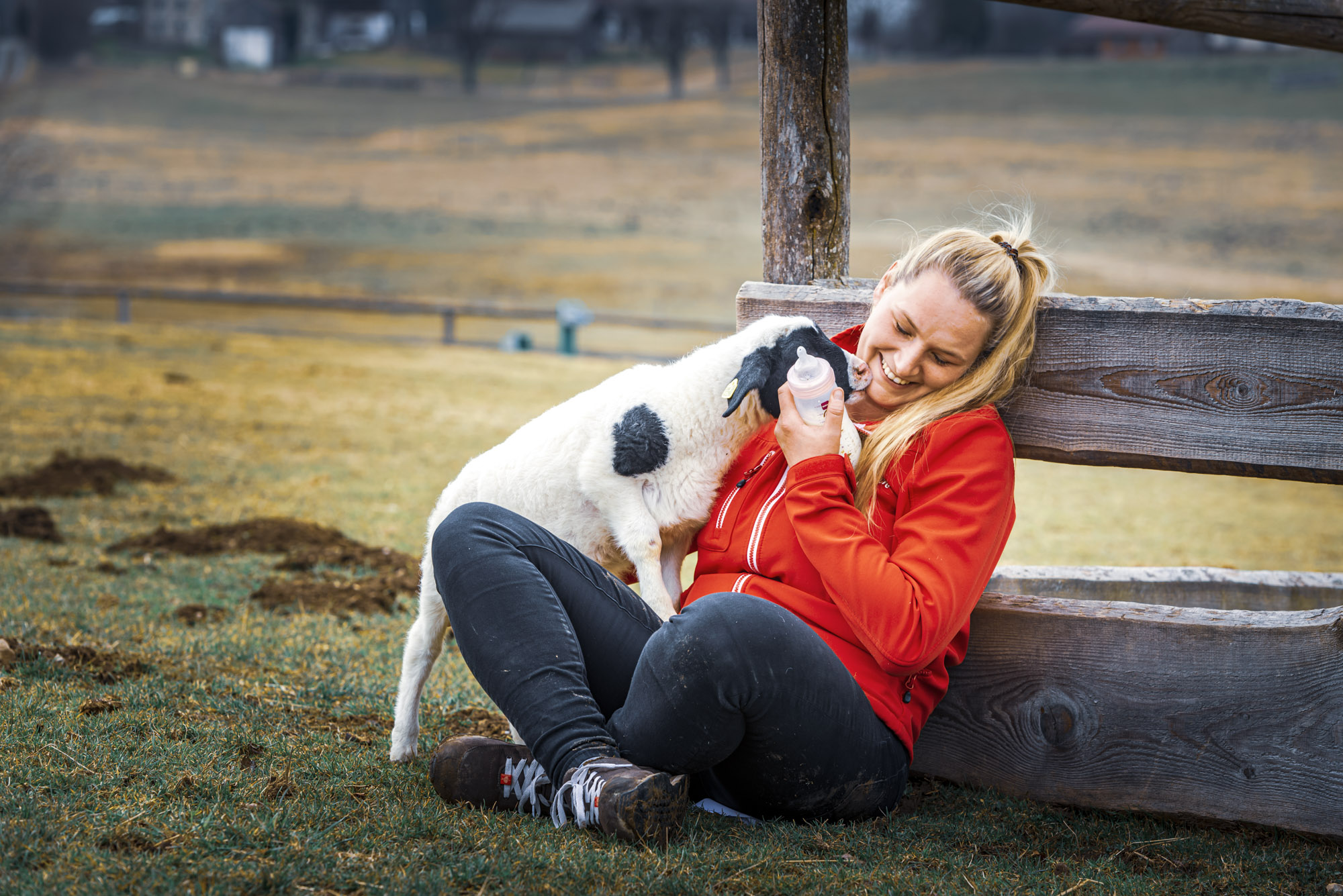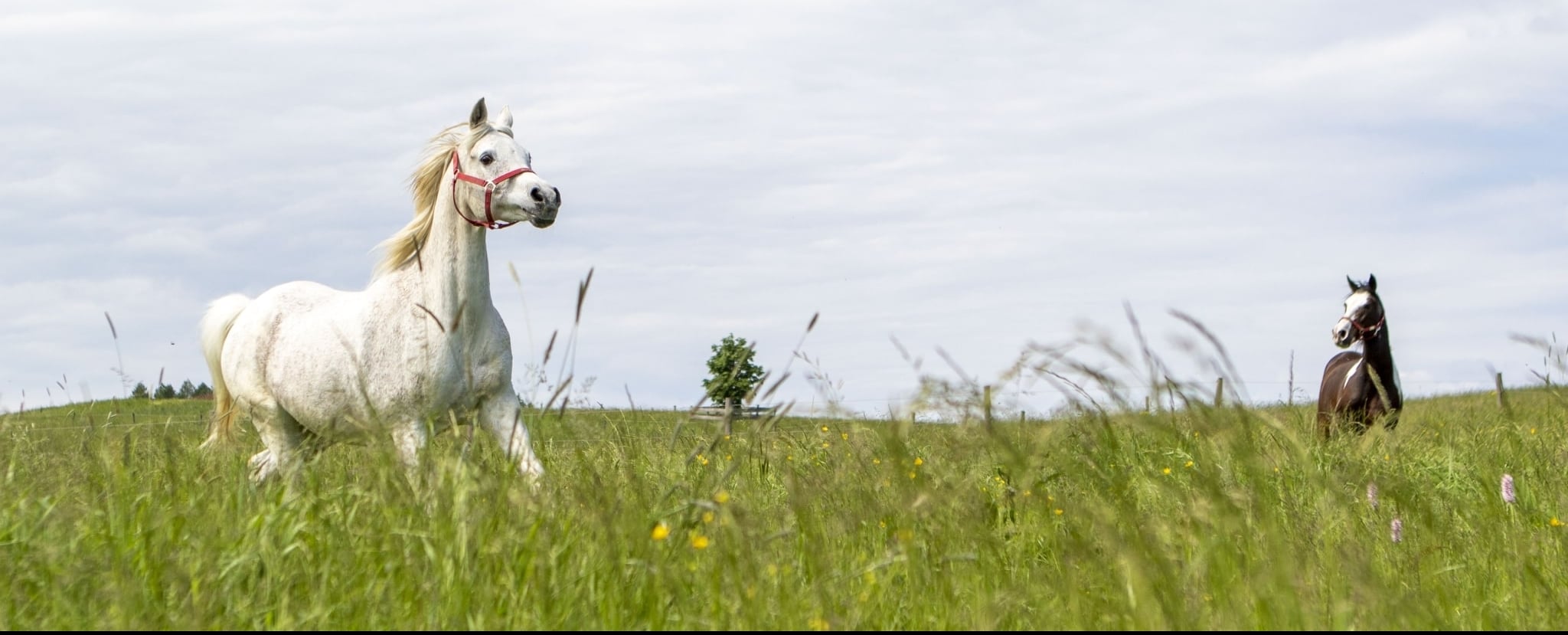
Wissenseinsatz
Neueste Forschungsergebnisse, erfolgreich umgesetzt
Für alle, die im Bereich Tierhaltung Verantwortung tragen, stellt der Parasitenbefall eine ständige Herausforderung dar. Bei weidenden Tieren stehen hier aus tiergesundheitlicher Sicht Magen-Darmwürmer im Vordergrund. Eine unzureichende Kontrolle kann schwere Erkrankungen und sogar Todesfälle zur Folge haben. Einem sorgfältig geplanten und umgesetzten Parasiten-Management kommt daher eine wichtige Bedeutung zu. Parasitenfreie Weidetiere sind in der Praxis nicht denkbar – die gute Nachricht ist jedoch, dass nicht jeder Parasitennachweis besorgniserregend und Anlass für eine Entwurmung ist, da gesunde Tiere mit einem moderaten Befall sehr gut leben können und diese Auseinandersetzung sogar positive Effekte für das Immunsystem haben kann. Anhand von zwei Projekten wird vorgestellt, wie bei Gut Aiderbichl auf fortschrittliche Weise Parasiten-Management bei Pferden, Eseln, Schafen und Ziegen betrieben wird.
Parasiten-Monitoring bei Equiden
Grundlage/Ausgangspunkt: Parasitenbefall stellt bei Tieren eine ständige Herausforderung dar. Bei Pferden, Eseln und Mulis stehen hier aus tiergesundheitlicher Sicht Magen-Darmwürmer im Vordergrund. Eine unzureichende Kontrolle kann zu schweren Erkrankungen und sogar Todesfällen führen. Dem Parasiten-Management aller bei Gut Aiderbichl beheimateten Equiden kommt daher eine sehr wichtige Bedeutung zu. Diagnostizieren lässt sich ein Parasitenbefall über eine Kotuntersuchung, jedoch ist nicht jeder Parasitennachweis besorgniserregend und Anlass für eine Entwurmung. Gesunde Tiere können mit einem moderaten Befall sehr gut leben und diese Auseinandersetzung kann sogar positive Effekte für das Immunsystem haben. Bis zum Jahr 2019 erfolgte die Parasitenkontrolle der Equiden bei Gut Aiderbichl an den meisten Standorten durch regelmässige Entwurmungen an drei oder vier Zeitpunkten der Saison.
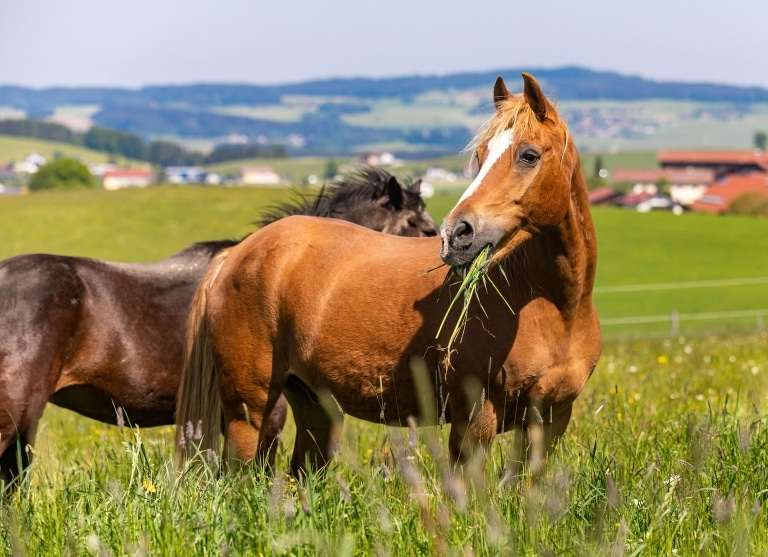
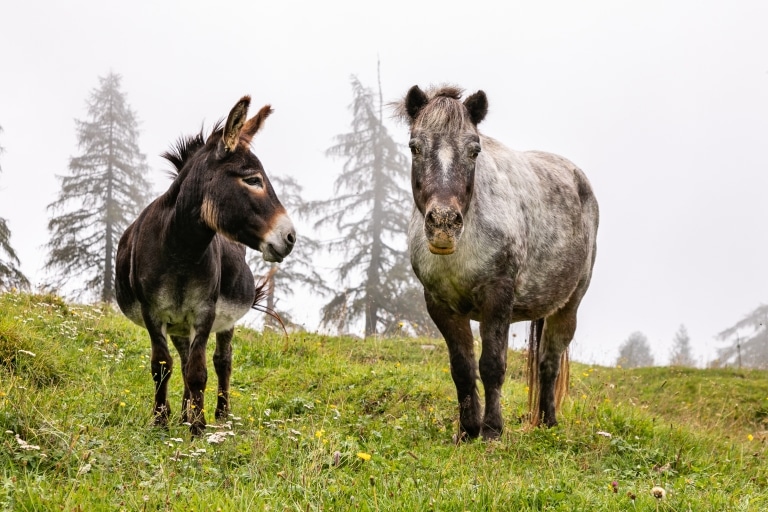
Ziel: Vor dem Hintergrund einer sich weltweit verschlimmernden Problematik durch resistente Parasiten wurde ab dem Jahr 2020 mit einer stufenweisen Neuausrichtung des Parasiten-Managements für die Equiden von GA begonnen. Mit der Einführung eines selektiven Entwurmungskonzepts nach Schweizer Vorbild wird das Ziel verfolgt, die Equiden zukünftig nur noch bedarfsabhängig auf Basis einer vorherigen Kotuntersuchung zu entwurmen. Mit der angestrebten Reduktion des Medikamenteneinsatzes soll eine unnötige Belastung der Tiere vermieden und eine Schonung ihres Umfeldes infolge ausgeschiedener Medikamentenrückstände erreicht werden. Die noch notwendigen Entwurmungen von Pferden mit einer erhöhten Parasiteneiausscheidung verhindern bei einer raschen Durchführung eine weitere Kontamination der Weideflächen und vermindern damit nachfolgende Infektionen anderer Pferde.
Neue Erkenntnisse: Im ersten Jahr des Monitorings (2020) ergaben an den zunächst sechs einbezogenen Standorten nur etwa 20 % der knapp 1000 durchgeführten Kotuntersuchungen einen Befund, der eine Entwurmung zur Folge hatte. Ausgehend davon war im Nachfolgejahr an den gleichen Standorten eine weitere Reduktion der Entwurmungsrate von 22 % zu verzeichnen. Dies ist bereits ein erster Hinweis für das erhebliche Potenzial des Monitorings, um die Behandlungsintensität künftig reduzieren zu können.
Ausblick: Da es sich beim parasitologischen Equiden-Monitoring um ein „open end“ Projekt handelt, wird es jährlich neue Erkenntnisse geben. Fortlaufende Evaluierung und gegebenenfalls Optimierungen der Beobachtung sind dabei unerlässlich und sorgen für eine kontinuierliche Entwicklung. Die neuesten Erkenntnisse und Entwicklungen können dann hier nachgelesen werden.
Publikation: Magazin „Leben Lieben“ – Frühjahr 2022
Projektleitung: PD Dr. Hubertus Hertzberg
Parasiten-Monitoring bei Kleinwiederkäuern
Grundlage/Ausgangspunkt: Der Befall mit Magen-Darmwürmern stellt bei Schafen und Ziegen aus tiergesundheitlicher Sicht einen der wesentlichen Problembereiche dar. Schafe und Ziegen entwickeln nur eine sehr schwache Immunität gegen die Parasiten, sodass nicht nur die Jungtiere, sondern auch die erwachsenen Tiere erkranken können und daher in die Kontrollmaßnahmen einbezogen werden müssen. Dem Parasiten-Management kommt daher eine sehr wichtige Bedeutung zu. Kotuntersuchungen bieten eine sehr gute Möglichkeit, den Umfang der Parasiteneiausscheidung beim Einzeltier zu diagnostizieren. Ein geringgradiger Befall kann von einem gesunden Tier gut toleriert werden. An den GA-Standorten, an denen infolge des umfangreicheren Weidekontaktes mit einem erhöhten Parasitenkontakt für die Schafe und Ziegen zu rechnen ist, wird seit dem Jahr 2021ein diagnostikbasiertes Parasiten-Management durchgeführt, in das am Hauptgut Henndorf auch die südamerikanischen Kameliden und Dromedare eingeschlossen sind.
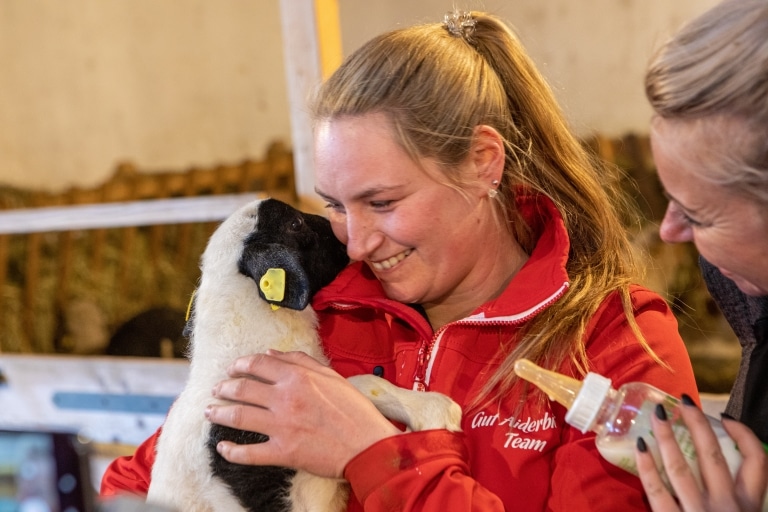
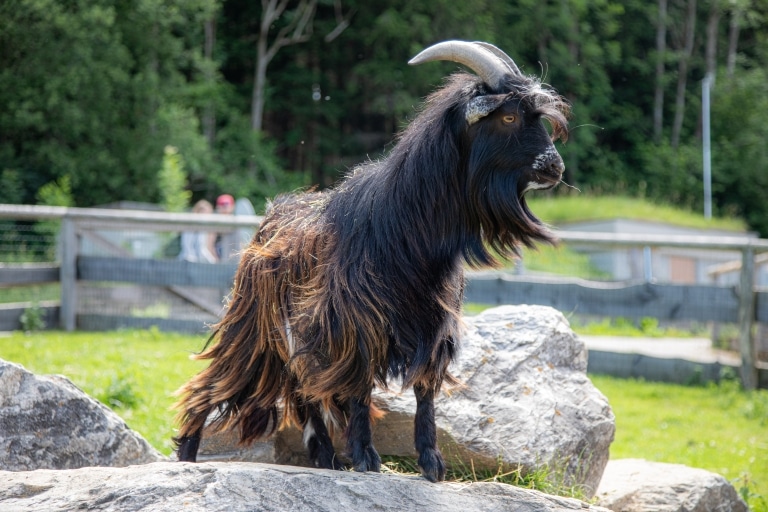
Ziel: Die weltweit stark fortschreitende Resistenzproblematik bei den Magen-Darmwürmern macht eine Neuorientierung beim Parasiten-Management der kleinen Wiederkäuer erforderlich. Für die bei Gut Aiderbichl beheimateten Tiere soll mittelfristig ein Wechsel von den Routinebehandlungen hin zu einem bedarfsgerechten Kontrollprogramm erfolgen. Die zeitnahe Durchführung und nachfolgende Überprüfung der Behandlungen werden einer weiteren Kontamination der Grünflächen mit Parasitenstadien entgegenwirken und nachfolgende Infektionen anderer Tiere vermindern. Mit der angestrebten Reduktion des Medikamenteneinsatzes soll eine unnötige Belastung der Tiere vermieden und eine Schonung ihres Umfeldes infolge ausgeschiedener Wirkstoffrückstände erreicht werden.
Neue Erkenntnisse: Die bisherigen – momentan noch begrenzten – Erfahrungen zeigen, dass die parasitologische Belastung einzelner Schafe und Ziegen auch innerhalb einer Gruppe sehr unterschiedlich sein kann und daher eine gezielte Selektion behandlungswürdiger Tiere im Hinblick auf die Reduktion des Medikamenteneinsatzes erstrebenswert wäre. Dies auch im Hinblick auf die ersten Beobachtungen, die an einzelnen Standorten erhebliche Einschränkungen bei der Wirksamkeit der eingesetzten Entwurmungsmittel erkennen lassen.
Ausblick: Die an den bisherigen Standorten erworbenen Erfahrungen stellen die Grundlage für eine Erweiterung des parasitologischen Monitorings auf weitere Standorte dar.
Projektleitung: PD Dr. Hubertus Hertzberg
Reha-Station der Sandgrueb-Stiftung für Equiden
Grundlage/Ausgangspunkt: Equiden mit schweren Erkrankungen stellen Tierbesitzer vor emotionale, finanzielle und medizinische Probleme, speziell dann, wenn es sich um Erkrankungen handelt, zu denen keine etablierte Therapie verfügbar ist. Die Krankheiten betreffen zudem häufig alte Pferde, was wiederum dazu führt, dass sie häufiger abgetreten werden oder sogar tierschutzrelevante Situationen entstehen. Dies resultiert leider häufig in Überforderung der Besitzer, die unter Umständen zu Vernachlässigung, Abgabe oder gar zum Tod der Tiere führen kann.
Im Auftrag von Gut Aiderbichl, nimmt sich die Sandgrueb-Stiftung speziell dieser Tiere an. In der Reha-Station in Egg bei Zürich wird mit erheblichem Aufwand versucht, Linderung der zugrunde liegenden Leidenssituationen zu ermöglichen. Dies ist jedoch aufgrund der eben oftmals fehlenden Therapie-Optionen eine sehr schwierige Aufgabe. In Zusammenarbeit mit der Vetsuisse-Fakultät der Universität Zürich und Vetmeduni Vienna wird intensiv daran gearbeitet, die Lebensqualität der geretteten Tiere stetig zu verbessern und wirksame Therapien zu entwickeln.
Die zu behandelnden Erkrankungen können sehr vielfältig sein, allerdings stechen sowohl durch die Häufigkeit als auch durch den Einfluss auf die Lebensqualität einige besonders hervor, nämlich chronische Lahmheiten, Sarkoide und andere Tumoren (z.B. Melanome), Hufkrebs, rezidivierende Hufabszesse, chronisch progressives Lymphödem (CPL) der Kaltblüter, Equines metabolisches Syndrom (EMS), Equines Cushing, Hufrehe, Zahnerkrankungen, um nur einige zu nennen.
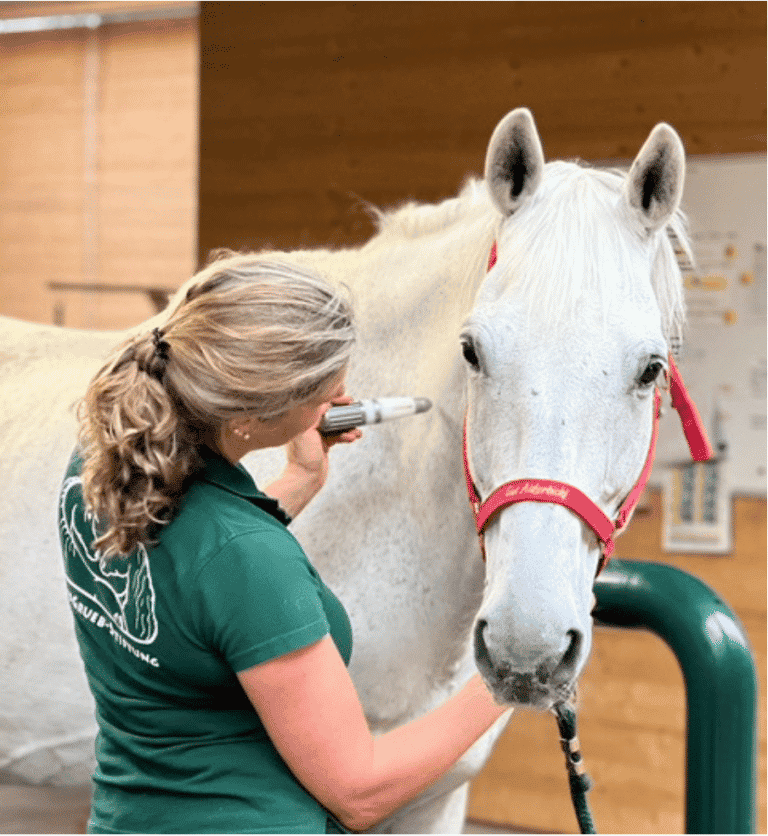
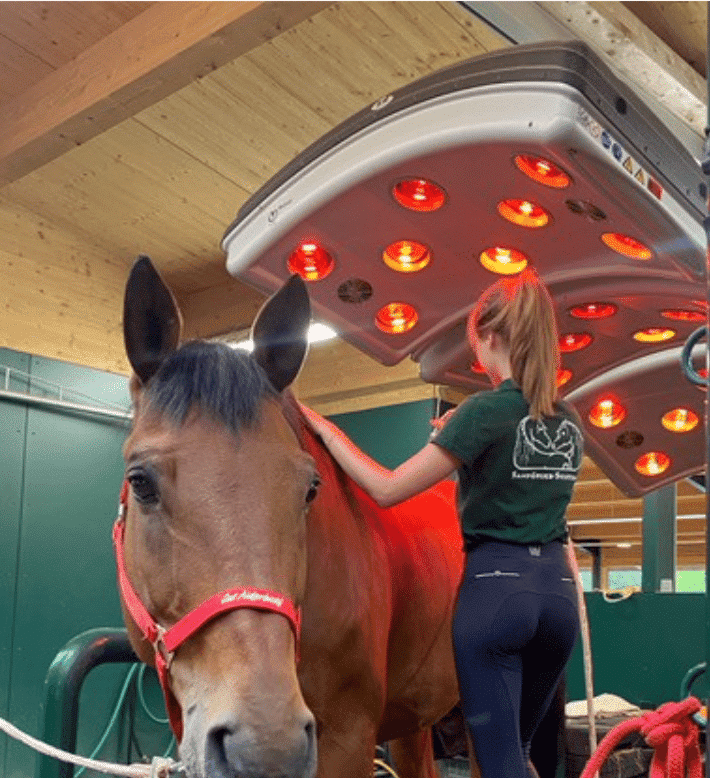
Ziel: In der Reha-Station steht ein ganzheitlicher Therapieansatz im Vordergrund. Neben der körperlichen Heilung ist auch das seelische Wohl der Pferde wichtig. Eine liebevolle Pflege und Betreuung, sowie ein herzlicher Umgang mit den Pferden, bei dem sich viel Zeit für jeden Patienten genommen wird, ist unerlässlich. Heilung basiert auf einer Kombination aus gesunder Psyche, tierärztlicher Behandlung, ausgewogenem Futter und Bewegung. Der Kontakt zu den Artgenossen ist dabei auch besonders wichtig.
Ziel ist es, Krankheiten erfolgreich und zielgerichtet zu therapieren und dabei neue Behandlungsmethoden zu entwickeln vor allem in Bereichen, in denen keine Therapien etabliert sind. Ein weiterer Schwerpunkt liegt in der individuell auf den Patienten abgestimmten Palliativtherapie zur Verbesserung der Lebensqualität unheilbar kranker Tiere.
Erkrankte Pferde mit schwer zu therapierenden Problemen, die intensive Betreuung benötigen, erhalten in der Reha-Station eine kontinuierliche, tierärztliche Betreuung und Pflege.
An der Entwicklung von einfach zu applizierenden Therapieansätzen wird intensiv gearbeitet, denn für die weit über 700 Pferde von Gut Aiderbichl, müssen schnell effektive und leicht durchführbare Behandlungsmöglichkeiten gefunden werden. Des Weiteren kann das hier gewonnene Wissen im weiteren Verlauf auf eine breitere Öffentlichkeit ausgedehnt werden, um das Bewusstsein für Erkrankungen z.B. alternder und chronisch kranker Pferde zu erhöhen und somit einen früheren Therapieeinstieg zu ermöglichen- damit Leiden entweder gar nicht erst entsteht oder frühzeitig reduziert werden kann.
Neue Erkenntnisse: Neben der Schulmedizin setzt die Reha-Station auch auf alternative, aber medizinisch fundierte Behandlungsmethoden.
Große Erfolge konnten bisher mit der Vetdrop®-Behandlung erzielt werden. Die Behandlung beinhaltet das Aufbringen konzentrierten Sauerstoffs, angereichert mit natürlichen und pharmazeutischen Substanzen (z.B. Urea, Hyaluronsäure, ätherische Öle) und erlaubt ein Eindringen dieser Mischung in tiefere Gewebeschichten. Behandelt werden können neben schmerzender Arthrose oder Sehnenverletzungen auch Entzündungen oder akute bzw. chronische Wunden.
Ebenfalls sehr gute Behandlungsergebnisse hat das Team mit der desinfizierenden und entzündungshemmenden Wirkung einer Desinfektionslösung (Xeron®) auf der Basis einer hochwirksamen hypochlorigen Säure (HOCL) erzielt. Dabei handelt es sich um saures oder neutrales Wasser mit einem pH-Wert von 4.7, respektive 7.0. Das Wasser wirkt durch Oxidation gegen Viren, Bakterien und Pilze. Es wird erfolgreich zur Behandlung akuter und chronisch infizierter Wunden eingesetzt, in Form von Angussverbänden bei Phlegmonen und tiefen Hautinfektionen, Mauke, Strahlfäule und vielem mehr.
Ausblick: Die Reha-Station kann in der Zusammenarbeit mit Gut Aiderbichl ein Weiterbildungszentrum sein, um die Mitarbeiter von Gut Aiderbichl zu schulen und mit den neuen Behandlungsmethoden vertraut zu machen. Weiterhin stellt die Reha-Station ein Zentrum für medizinische Betreuung besonders schwer erkrankter und behandlungsintensiver Pferde von Gut Aiderbichl dar.
Projektleitung: Dr.med.vet. Karina Klein, DVM-PhD, Tierspital Zürich
Die naturnahe Haltung ist die artgerechteste Lebensweise für Tiere. Gleichzeitig ist sie nachhaltig und bietet die größten Möglichkeiten, die Artenvielfalt zu erhalten. Pferde, die Tag und Nacht auf der Weide verbringen, richten ihren Tagesablauf ganz anders aus als in von Menschen gesteuerten Haltungssystemen. Gesundes Futter steht in der Natur immer zur Verfügung, sodass die Pferde ungünstiger Witterung und Insektenplagen ausweichen können. Leider können viele Equiden heute nicht mehr frei auf der Weide leben, weil sie durch Wohlstandserkrankungen bedroht sind. Daher beschäftigen sich verschiedene Projekte bei Gut Aiderbichl mit der Zusammensetzung der Futtergrasflächen, ihrer Optimierung durch geeignetes Saatgut und mit der Qualität des daraus gewonnenen Heus. Die Futterflächen sind die Grundlage für eine naturnahe Haltung und somit für die psychische und physische Gesundheit der Tiere.
Kompostierung
Grundlage/Ausgangspunkt: Im Durchschnitt produziert ein Pferd zwischen 20 und 30 kg Mist pro Tag, was etwa 7 bis 10 Tonnen oder 20 bis 30 m³ pro Jahr entspricht. Das sind große Mengen an Mist, die ein Stall verwalten muss. Dieser Mist enthält große Mengen an Nährstoffen, die bei richtiger Behandlung den Stoffkreislauf schließen können. Er kann jedoch auch Krankheitserreger, Parasiten oder Unkraut enthalten, die man nicht verbreiten möchte. Daher soll eine angemessene und wirtschaftlich vertretbare Aufwertung des Mists in Betracht gezogen werden.
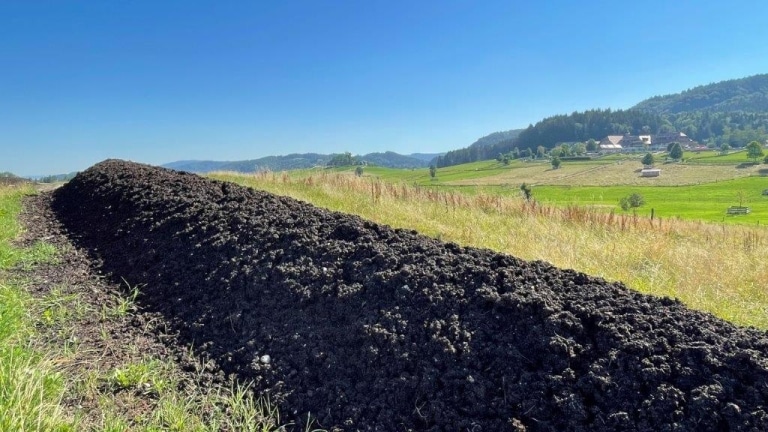
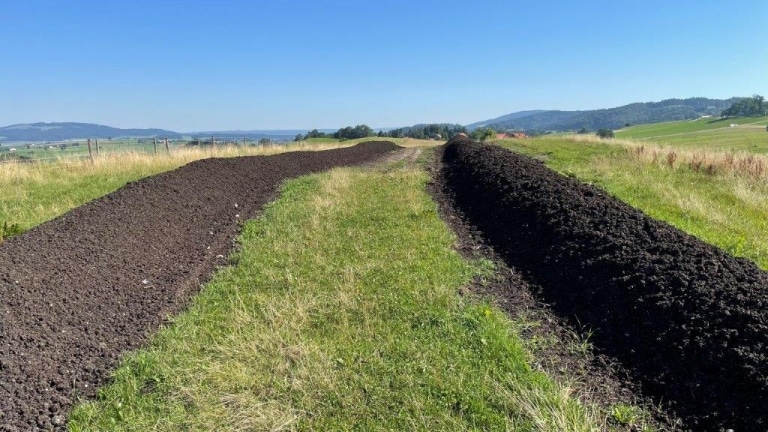
Ziel: Ziel dieses Projekts ist die Einrichtung eines optimierten Kompostierungssystems bei Gut Aiderbichl für die Behandlung von Pferdemist. Ein Qualitätskonzept, das von der Sammlung des Mists über das Management des Prozesses selbst bis hin zur Verwendung des erzeugten Komposts reicht, wird dieses Projekt begleiten. Schon jetzt ist bei der Kompostierung eine dreifache Volumenverringerung zu beobachten. Der erzeugte Kompost kann somit gelagert und zu den idealen Zeitpunkten für Wiesen verwendet werden. Außerdem wird während des Kompostierungsprozesses ein natürlicher „Hygienisierungseffekt“ des Mists erzielt, da die Temperatur des Materials bis zu 65°C erreicht. Kompost, der nicht benötigt wird, muss von einwandfreier Qualität sein, um auf den Markt gebracht werden zu können, insbesondere für Hobbygärtner. Um dieses Ziel zu erreichen, werden die Mitarbeiter von Gut Aiderbichl in der Kompostierung geschult.
Neue Erkenntnisse: Zur Behandlung des Mists wird die Kompostierung am Feldrand eingesetzt. Sie wird für die verschiedenen Situationen in den ausgewählten Gut Aiderbichl Höfen optimiert, je nach Art der Einstreu und der zur Verfügung stehenden organischen Nebenabfälle. Parallel dazu kann eine Studie über die Inaktivierung von Krankheitserregern, Parasiten und Unkräutern während des Kompostierungsprozesses durchgeführt werden.
Ausblick: Auf der Grundlage der während des Projekts erzielten Ergebnisse wird eine Richtlinie erarbeitet, die als Basis zur Umsetzung auf anderen Höfen dient. Diese Richtlinie wird sich nicht nur mit dem Management des Kompostierungsprozesses selbst, sondern auch mit der Verwendung des erzeugten Qualitätskomposts befassen. Eine wirtschaftliche Bewertung des Konzepts wird dieses Projekt abrunden.
Projektleitung: Dr. Jacques Fuchs, FiBL Schweiz
Grasland
Grundlage/Ausgangspunkt: Das wichtigste Gras für die Wirtschaft in Europa ist das deutsche Weidegras. Es findet sich in Standard-Saatgutmischungen für Pferdeweiden und Pferdeheuwiesen. Von besonderer Bedeutung ist es in der Milchviehhaltung, weil es energie- und eiweißreich ist. Pferde und Esel kommen jedoch mit minimaler Nahrung aus und können dabei maximale Bewegungsleistung erbringen. Diese Genetik, die die Voraussetzung bei der Auswahl der Vorfahren war, bedroht unsere Pferde heute durch Wohlstandserkrankungen, insbesondere Gnadenbrotpferde. Neben Verfettung kommt es im Laufe der Jahre zu schweren Stoffwechselstörungen, vergleichbar der Diabetes beim Menschen, die beim Pferd zu lebensbedrohlichen Krankheiten wie der Hufrehe führen. Eine Futterreduktion kann zu Verdauungsstörungen und Schleimhautentzündungen des Verdauungstraktes führen. Auch kurzgenagte Ausläufe sind keine Alternative, denn sie stellen eine Selektion auf ungesunde Pflanzen dar.
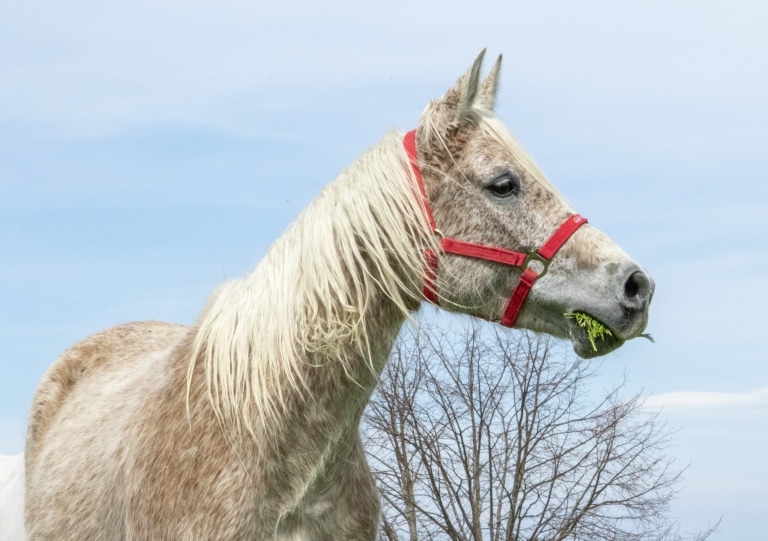
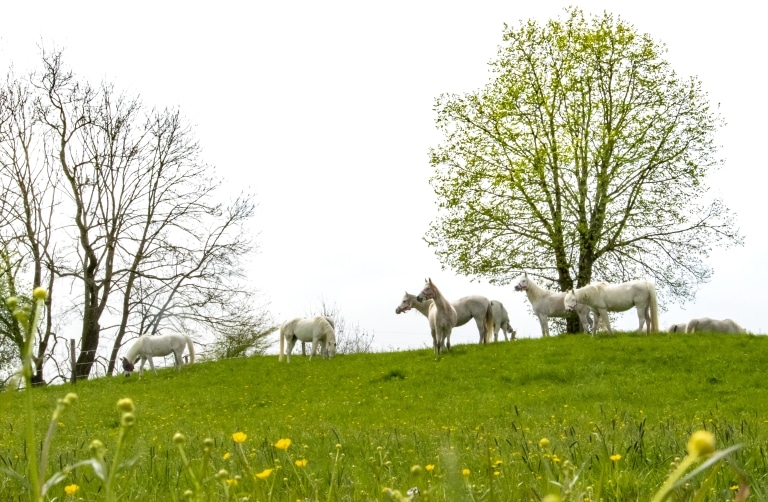
Ziel: Auf den Gut Aiderbichl-Höfen finden sich Grasländer mit ganz unterschiedlicher Vegetation. Gleichzeitig gibt es unterschiedliche Ansprüche an das Futter, je nach Gesundheitszustand der Tiere. Seit 2021 wird auf den Höfen die Vegetation aufgezeichnet, um zu sehen, welche Grasländer für alte Pferde geeignet sind und welche weniger. Zu gehaltvolle Flächen sollen in Richtung einer gesünderen Futtergrundlage verändert werden. Von Verfettung bedrohte Pferde und Esel brauchen altes Dauergrasland aus ertragsarmen Wildgräsern und wilden (Heil-) Kräutern. Die Pflanzenzusammensetzung spiegelt dabei den Standort mit seinen Böden, seiner Witterung und Nutzung wider. Jeder Hof wird seine individuelle Komposition entwickeln, die wiederum gezielt die Tiere ernähren soll, die genau damit optimal gesund leben können.
Neue Erkenntnisse: In Trevol (Frankreich) und Szepalma (Ungarn) besteht aufgrund der Böden und des Klimas die Möglichkeit, artenreiche Halbtrockenrasen entstehen zu lassen. Diese kräuterreiche Vegetation gilt als besonders gesund für empfindliche Robustpferderassen. Das Gut Aiderbichl Iffeldorf (Deutschland) könnte mit Wiesen-Fuchsschwanzwiesen hohe Erntemengen an rohfaserreichem, energiearmem Heu einfahren. Die Talwiesen auf Gut Aiderbichl Henndorf (Österreich) bieten ein kleinräumiges Mosaik ganz unterschiedlicher Zusammensetzungen. Hier finden sich sogar an Orchideen und Sauergräsern reiche Wiesen, um ein kleines Moor aus Torfmoos und Wollgras.
Ausblick: Gut Aiderbichl betritt Neuland. Derart unterschiedliche Flächen unter einem Dach sind einzigartig und lassen eine Forschung an Zusammenhängen zwischen Futtergrundlage und Tiergesundheit zu, die wegweisend für die Pferdehaltung der Zukunft sein können. Wir werden an dieser Stelle darüber berichten.
Publikation: Link zu
Projektleitung:
Saatgut
Grundlage/Ausgangspunkt: Die im Handel befindlichen Saatgutmischungen für Pferdeweiden und Pferdeheuwiesen orientieren sich an den sogenannten Standardmischungen für Pferde und sind artenarm. Darin verwendete Hochleistungsgräser forcieren die Verarmung der Flora und Fauna auf den Grasländern von Pferdehaltern. Hochleistungsgräser produzieren Aufwüchse (ein Belag aus Mikroorganismen), die deutlich energiereicher sind als die Landschaften, aus denen Pferde und Esel ursprünglich stammen. Eine wissenschaftliche Studie aus dem Jahr 2020 brachte zudem ans Licht, dass etwa jede vierte bis fünfte gehandelte Saatgutmischung für Grasland infiziert ist mit Pilzen, sogenannten Endophyten. Diese Pilze verleihen dem angesäten grünen Gras die züchterisch erwünschte besondere Widerstandskraft bei Dürre, Nährstoffmangel und Überweidung.
Die „Wirtsgräser“ der Pilze sind dabei Weidegras und Schwingel. Für Pferde sind einige Wirkstoffe der Pilze besonders giftig, denn diese Gifte wirken wie Umwelthormone (endokrine Disruptoren).
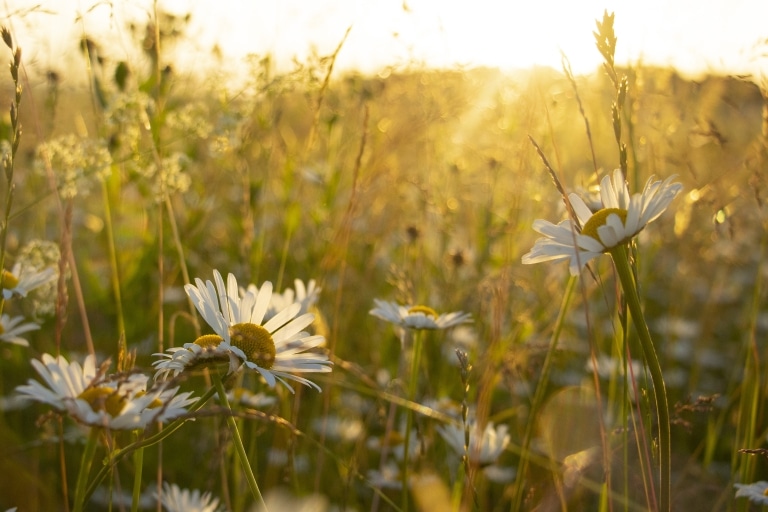
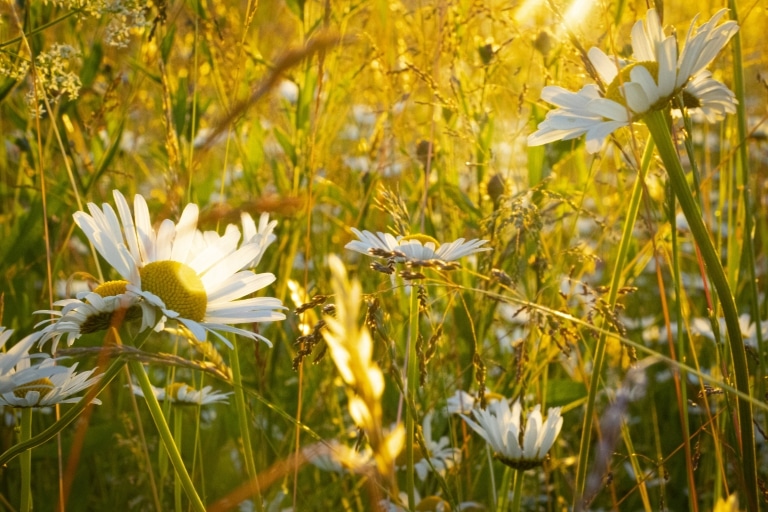
Ziel: Gut Aiderbichl will vorsorgen. Das in sechs verschiedenen europäischen Staaten gelegene Grasland wird auf das Vorhandensein dieser Pilze getestet. Statt weiterhin Zuchtsaatgut aus dem Handel zu nutzen, sollen Einschleppungspfade unterbrochen und Kreisläufe geschlossen werden. Dazu wird auf den eigenen Höfen nach geeigneten Spenderflächen in direkter Nachbarschaft gesucht. Gut Aiderbichl will sein eigenes Wildsaatgut aus nachweislich ungiftigen und in seiner Pflanzenzusammensetzung für Pferde geeigneten Grasländern gewinnen. Zur Reifezeit als Mulchschnitt geerntet, kann der Aufwuchs der Spenderfläche als Saatgutübertragung lückige Flächen mit Samen versorgen und die Vielfalt artenarmer Flächen erhöhen. Zusätzlich wird in Kooperation mit staatlichen Institutionen eine Erhöhung der Biodiversität durch die Verwendung von regionalem Wildsaatgut angestrebt.
Neue Erkenntnisse: Die Flächen von Gut Aiderbichl sind bisher überwiegend frei von giftigen Endophyten. Hohe Saatguteinträge, auch von nicht standorttypischen Pflanzen zeigen Flächen mit hohem Tierbesatz bei ständiger Heufütterung. Zugekauftes Heu enthält Samen, die den Verdauungstrakt unbeschadet passieren. Mit dem nährstoffreichen Dung gelangen sie auf die Flächen und keimen. Der Dung stellt eine oft übersehene Quelle der Samenverbreitung dar. Für Tierhalter sind Flächen hoher Artenvielfalt nicht erkennbar. Vegetationsaufnahmen durch Experten sind daher unerlässlich, sollen Saatgutschätze gehoben und Verluste seltener Pflanzen vermieden werden.
Ausblick: Ökosysteme sind dynamisch. Sie sind ständigen Einflüssen und Veränderungen unterworfen. Eine dauerhafte Begleitung der Futtergrundlagen durch Experten hilft, unerwünschte Veränderungen rechtzeitig zu erkennen. Neben dem Eindringen von gefährlichen Giftpflanzen und leicht übersehenen giftigen Pilzen in die Futterflächen betrifft das insbesondere den drohenden Verlust der Artenvielfalt.
Publikation: Link zu
Projektleitung:
Heuqualität
Grundlage/Ausgangspunkt: Auch im Heu sind die Energiegehalte für viele Pferde und Esel viel zu hoch. Ausgerechnet das Heu, das nach allen Kriterien die Pferdehalter lernen das Beste ist, hat die höchsten Energiegehalte. Die Österreichische Arbeitsgemeinschaft für Grasland und Viehwirtschaft (ÖAG) stellt fest, dass eben das Heu, das nach allen Richtlinien als bestes Heu beurteilt wird und von fast allen Pferdehaltern angestrebt wird, für „Spitzenpferde in Sport und Zucht“ geeignet ist. Für Robustrassen (z.B. Noriker, Haflinger) werden Heuchargen mit weniger als der halben erreichbaren Punktzahl in der Bewertung von der ÖAG gesehen. Die Gnadenbrotpferde von Gut Aiderbichl benötigen also ein völlig anderes Heu als das, was Sportpferde in Reitställen erhalten. Erschwerend kommt hinzu, dass bei alten Pferden die Zähne zunehmend abnutzen. Derbes Raufutter können diese Tiere dann nicht mehr kauen.
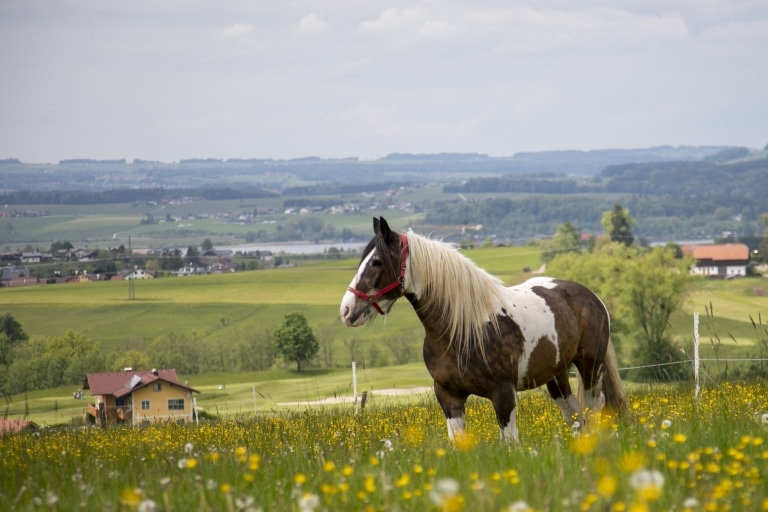
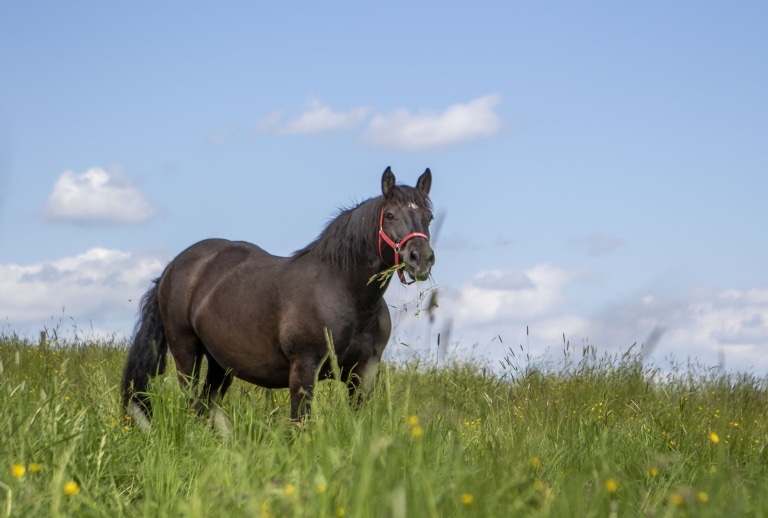
Ziel: Aromatisch duftendes Heu von grüner Farbe, blattreich und nicht zu derb, kann vielen Pferden nur rationiert gefüttert werden. Lange Fresspausen können jedoch Schleimhaut-Geschwüre in Magen und Darm provozieren und sind damit tierschutzrelevant. Langsames Fressen über einen langen Zeitraum von energiearmen Aufwüchsen ist für viele Gnadenbrotpferde ein anzustrebendes Ziel.
Neue Erkenntnisse: Gut Aiderbichl will mithilfe der Etikettierung jedes einzelnen Ballens noch auf dem Heufeld seine Qualität überprüfen und eine Rückverfolgbarkeit herstellen. Über ein Protokoll wird der Werdegang jedes Ballens lückenlos dokumentiert: Heufläche, Schnittzeitpunkt, Temperaturverlauf, Restfeuchte etc. Diese Angaben werden aufzeigen, wo es Probleme gibt, die abgestellt werden müssen. Parallel dazu werden von jeder Heucharge Proben für Laboranalysen eingeschickt, um den Energie- und Proteingehalt sowie eventuelle Pilzinfektionen zu bestätigen.
Ausblick: Die hygienische Qualität verlangt staubarmes Heu, frei von Schimmelpilzen und Giften. Zarte Kräuterblätter enthalten viele Mineralien, Eiweiße und pflanzliche Wirkstoffe der Heilkräuter, die für alte und kranke Tiere besonders wertvoll sind. Hier ist ein weites Experimentierfeld, das noch spannende Ergebnisse abwerfen wird!
Publikation: Link zu
Projektleitung:
